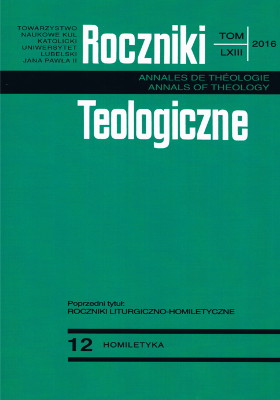Liturgiczny obraz Trójjedynego Boga
The Image of the Triune God in the Liturgy
Author(s): Bogusław MigutSubject(s): Christian Theology and Religion, Theology and Religion, Pastoral Theology
Published by: Towarzystwo Naukowe KUL & Katolicki Uniwersytet Lubelski Jana Pawła II
Keywords: Most Holy Trinity; Liturgy; Eucharist; Symbol; Image; Liturgical Theology; Alexander Schmemann; Tomáš Špidlík; Achille Maria Triacca
Summary/Abstract: Liturgy does not only express the events of salvation in the perspective of the heavenly liturgy. Beyond its causative dimension − that is, its action ex opero operato − with respect to the saving mystery of God, it is a symbol of this same mystery, an image, even, of it. In this context the imagery of the liturgy must be properly understood, and to this end, the significance also of the attributed symbol. Alexander Schmemann says that in the original understanding, a symbol is a manifestation and a presence of another reality, which in given conditions may not be exhibited other than in and through this reality. An external likeness between the visible dimension of the symbol and the thing it actually symbolizes, while not essential, and can sometimes even trivialize the symbol, is not however uncommon. This pertains particularly to the Church itself and its liturgy, where symbolism has been shaped by salvation history and has a source of its own in Sacred Scripture. Thus it is possible, and even necessary, to speak of the symbolic imagery of the whole liturgical celebration.The Church and its liturgy are a reflection of the Most Holy Trinity, since they are the common action of the three Divine Persons. The Church is the principle tool of the work of salvation and its continuation in time, but it also carries within it an internal symbol/image of the unity and love of the Persons of the Most Holy Trinity and their outward mission/message. Cardinal Tomáš Špidlík shows this on the basis of the theology of the Fathers of the Church in relation to the teachings of Vatican II.Liturgical theology presents the trinitarian source of Christian love and unity as well as Christian solidarity. The communion of the Persons of the Holy Trinity, revealing itself in every liturgy and especially in the Eucharist, is the source of all unity − from unity within the Church and between particular ecclesial communities to every type of human connection.
Journal: Roczniki Teologiczne
- Issue Year: 63/2016
- Issue No: 12
- Page Range: 75-86
- Page Count: 12
- Language: Polish

